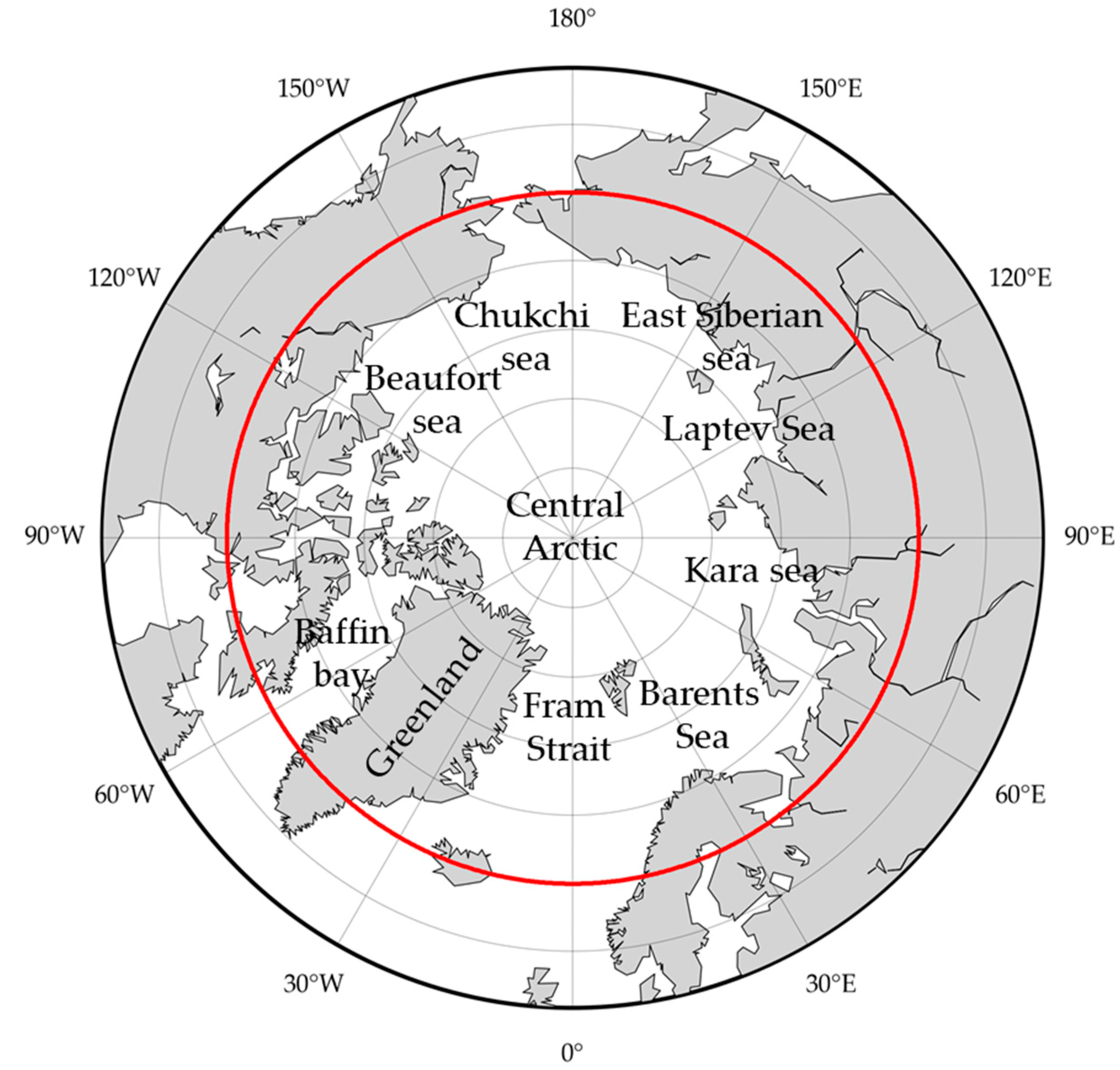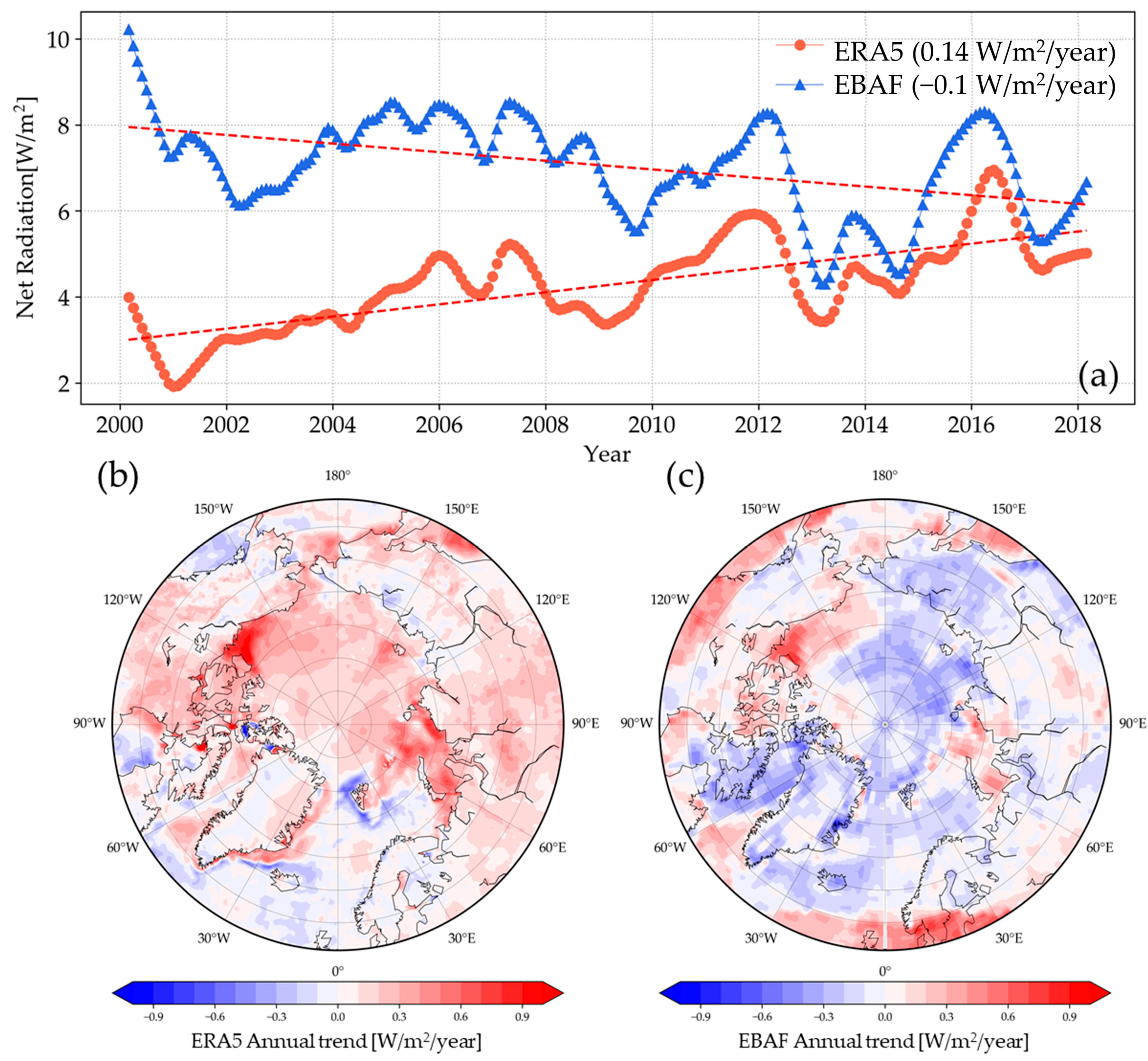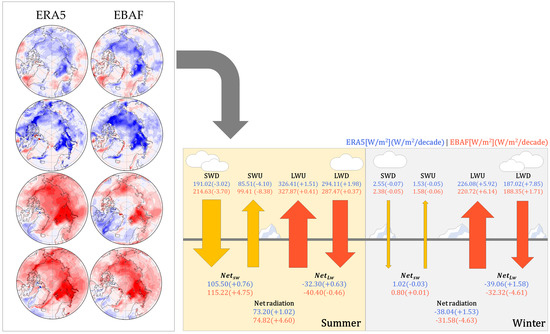Variability of Surface Radiation Budget over Arctic during Two Recent Decades from Perspective of CERES and ERA5 Data
Abstract
:1. Introduction
2. Materials and Methods
2.1. Definition of Net Radiation
2.1.1. ERA5
2.1.2. CERES EBAF
2.1.3. Climatic Variables
2.2. Methods
3. Long-Term Trend in Surface Radiation Budget
3.1. Net Radiation
3.2. Components of Net Radiation
4. Surface Radiation Budget in the Arctic Circle
4.1. Estimation of Extreme Seasons
4.2. Changes in the Surface Radiation Budget in Extreme Seasons
4.3. Surface Radiation Budget in the Arctic
5. Discussion
6. Conclusions
Author Contributions
Funding
Data Availability Statement
Acknowledgments
Conflicts of Interest
References
- Maslanik, J.A.; Key, J.; Fowler, C.W.; Nguyen, T.; Wang, X. Spatial and Temporal Variability of Satellite-Derived Cloud and Surface Characteristics during FIRE-ACE. J. Geophys. Res. Atmos. 2001, 106, 15233–15249. [Google Scholar] [CrossRef]
- Kay, J.E.; L’Ecuyer, T. Observational Constraints on Arctic Ocean Clouds and Radiative Fluxes during the Early 21st Century. J. Geophys. Res. Atmos. 2013, 118, 7219–7236. [Google Scholar] [CrossRef]
- Christensen, M.W.; Behrangi, A.; L’ecuyer, T.S.; Wood, N.B.; Lebsock, M.D.; Stephens, G.L. Arctic Observation and Reanalysis Integrated System: A New Data Product for Validation and Climate Study. Bull. Am. Meteorol. Soc. 2016, 97, 907–916. [Google Scholar] [CrossRef]
- Riihelä, A.; Key, J.R.; Meirink, J.F.; Kuipers Munneke, P.; Palo, T.; Karlsson, K.-G. An Intercomparison and Validation of Satellite-Based Surface Radiative Energy Flux Estimates over the Arctic. J. Geophys. Res. Atmos. 2017, 122, 4829–4848. [Google Scholar] [CrossRef]
- Serreze, M.C.; Barrett, A.P.; Stroeve, J.C.; Kindig, D.N.; Holland, M.M. The Emergence of Surface-Based Arctic Amplification. Cryosphere 2009, 3, 11–19. [Google Scholar] [CrossRef]
- Laîné, A.; Yoshimori, M.; Abe-Ouchi, A. Surface Arctic Amplification Factors in CMIP5 Models: Land and Oceanic Surfaces and Seasonality. J. Clim. 2016, 29, 3297–3316. [Google Scholar] [CrossRef]
- Sejas, S.A.; Cai, M.; Hu, A.; Meehl, G.A.; Washington, W.; Taylor, P.C. Individual Feedback Contributions to the Seasonality of Surface Warming. J. Clim. 2014, 27, 5653–5669. [Google Scholar] [CrossRef]
- Previdi, M.; Smith, K.L.; Polvani, L.M. Arctic Amplification of Climate Change: A Review of Underlying Mechanisms. Environ. Res. Lett. 2021, 16, 093003. [Google Scholar] [CrossRef]
- Wang, X.; Key, J.R. Arctic Surface, Cloud, and Radiation Properties Based on the AVHRR Polar Pathfinder Dataset. Part I: Spatial and Temporal Characteristics. J. Clim. 2005, 18, 2558–2574. [Google Scholar] [CrossRef]
- Wild, M. Decadal Changes in Radiative Fluxes at Land and Ocean Surfaces and Their Relevance for Global Warming. WIREs Clim. Chang. 2016, 7, 91–107. [Google Scholar] [CrossRef]
- Wild, M. Global Dimming and Brightening: A Review. J. Geophys. Res. Atmos. 2009, 114, D00D16. [Google Scholar] [CrossRef]
- Mazhar, U.; Jin, S.; Duan, W.; Bilal, M.; Ali, M.A.; Farooq, H. Spatio-Temporal Trends of Surface Energy Budget in Tibet from Satellite Remote Sensing Observations and Reanalysis Data. Remote Sens. 2021, 13, 256. [Google Scholar] [CrossRef]
- Serreze, M.C.; Barrett, A.P.; Slater, A.G.; Steele, M.; Zhang, J.; Trenberth, K.E. The Large-Scale Energy Budget of the Arctic. J. Geophys. Res. 2007, 112, D11122. [Google Scholar] [CrossRef]
- Tsubouchi, T.; Bacon, S.; Aksenov, Y.; Garabato, A.C.N.; Beszczynska-Möller, A.; Hansen, E.; de Steur, L.; Curry, B.; Lee, C.M. The Arctic Ocean Seasonal Cycles of Heat and Freshwater Fluxes: Observation-Based Inverse Estimates. J. Phys. Oceanogr. 2018, 48, 2029–2055. [Google Scholar] [CrossRef]
- Mayer, M.; Tietsche, S.; Haimberger, L.; Tsubouchi, T.; Mayer, J.; Zuo, H. An Improved Estimate of the Coupled Arctic Energy Budget. J. Clim. 2019, 32, 7915–7934. [Google Scholar] [CrossRef]
- Allan, R.P. Evaluation of Simulated Clear-Sky Longwave Radiation Using Ground-Based Observations. J. Clim. 2000, 13, 1951–1964. [Google Scholar] [CrossRef]
- Seo, M.; Lee, E.; Lee, K.; Choi, S.; Jin, D.; Seong, N.; Han, H.; Kim, H.-C.; Han, K. Comparative Analysis of Radiative Flux Based on Satellite over Arctic. Korean J. Remote Sens. 2018, 34, 1193–1202. [Google Scholar] [CrossRef]
- Seo, M.; Kim, H.-C.; Lee, K.-S.; Seong, N.-H.; Lee, E.; Kim, J.; Han, K.-S. Characteristics of the Reanalysis and Satellite-Based Surface Net Radiation Data in the Arctic. J. Sens. 2020, 2020, e8825870. [Google Scholar] [CrossRef]
- Wang, X.; Key, J.R. Recent Trends in Arctic Surface, Cloud, and Radiation Properties from Space. Science 2003, 299, 1725–1728. [Google Scholar] [CrossRef]
- Garrett, T.J.; Zhao, C. Increased Arctic Cloud Longwave Emissivity Associated with Pollution from Mid-Latitudes. Nature 2006, 440, 787–789. [Google Scholar] [CrossRef]
- Nicolaus, M.; Katlein, C.; Maslanik, J.; Hendricks, S. Changes in Arctic Sea Ice Result in Increasing Light Transmittance and Absorption. Geophys. Res. Lett. 2012, 39, 2012GL053738. [Google Scholar] [CrossRef]
- Park, H.-S.; Lee, S.; Kosaka, Y.; Son, S.-W.; Kim, S.-W. The Impact of Arctic Winter Infrared Radiation on Early Summer Sea Ice. J. Clim. 2015, 28, 6281–6296. [Google Scholar] [CrossRef]
- Gong, T.; Feldstein, S.; Lee, S. The Role of Downward Infrared Radiation in the Recent Arctic Winter Warming Trend. J. Clim. 2017, 30, 4937–4949. [Google Scholar] [CrossRef]
- Lee, K.-S.; Jin, D.; Yeom, J.-M.; Seo, M.; Choi, S.; Kim, J.-J.; Han, K.-S. New Approach for Snow Cover Detection through Spectral Pattern Recognition with MODIS Data. J. Sens. 2017, 2017, e4820905. [Google Scholar] [CrossRef]
- Curry, J.A.; Schramm, J.L.; Ebert, E.E. Sea Ice-Albedo Climate Feedback Mechanism. J. Clim. 1995, 8, 240–247. [Google Scholar] [CrossRef]
- Chapin, F.S.; Sturm, M.; Serreze, M.C.; McFadden, J.P.; Key, J.R.; Lloyd, A.H.; McGuire, A.D.; Rupp, T.S.; Lynch, A.H.; Schimel, J.P.; et al. Role of Land-Surface Changes in Arctic Summer Warming. Science 2005, 310, 657–660. [Google Scholar] [CrossRef]
- Przybylak, R. The Climate of the Arctic; Atmospheric and Oceanographic Sciences Library; Springer International Publishing: Cham, Switzerland, 2016; Volume 52, ISBN 978-3-319-21695-9. [Google Scholar]
- Morrison, A.L.; Kay, J.E.; Chepfer, H.; Guzman, R.; Yettella, V. Isolating the Liquid Cloud Response to Recent Arctic Sea Ice Variability Using Spaceborne Lidar Observations. J. Geophys. Res. Atmos. 2018, 123, 473–490. [Google Scholar] [CrossRef]
- Morrison, A.L.; Kay, J.E.; Frey, W.R.; Chepfer, H.; Guzman, R. Cloud Response to Arctic Sea Ice Loss and Implications for Future Feedback in the CESM1 Climate Model. JGR Atmos. 2019, 124, 1003–1020. [Google Scholar] [CrossRef]
- Seo, M.; Kim, H.-C.; Huh, M.; Yeom, J.-M.; Lee, C.S.; Lee, K.-S.; Choi, S.; Han, K.-S. Long-Term Variability of Surface Albedo and Its Correlation with Climatic Variables over Antarctica. Remote Sens. 2016, 8, 981. [Google Scholar] [CrossRef]
- Riihelä, A.; Manninen, T.; Laine, V. Observed Changes in the Albedo of the Arctic Sea-Ice Zone for the Period 1982–2009. Nat. Clim Chang. 2013, 3, 895–898. [Google Scholar] [CrossRef]
- Crawford, T.M.; Duchon, C.E. An Improved Parameterization for Estimating Effective Atmospheric Emissivity for Use in Calculating Daytime Downwelling Longwave Radiation. J. Appl. Meteorol. Climatol. 1999, 38, 474–480. [Google Scholar] [CrossRef]
- Wang, X.; Liu, J.; Yang, B.; Bao, Y.; Petropoulos, G.P.; Liu, H.; Hu, B. Seasonal Trends in Clouds and Radiation over the Arctic Seas from Satellite Observations during 1982 to 2019. Remote Sens. 2021, 13, 3201. [Google Scholar] [CrossRef]
- Di Biagio, C.; Pelon, J.; Blanchard, Y.; Loyer, L.; Hudson, S.R.; Walden, V.P.; Raut, J.-C.; Kato, S.; Mariage, V.; Granskog, M.A. Toward a Better Surface Radiation Budget Analysis Over Sea Ice in the High Arctic Ocean: A Comparative Study Between Satellite, Reanalysis, and Local-Scale Observations. J. Geophys. Res. Atmos. 2021, 126, e2020JD032555. [Google Scholar] [CrossRef]
- Jia, A.; Jiang, B.; Liang, S.; Zhang, X.; Ma, H. Validation and Spatiotemporal Analysis of CERES Surface Net Radiation Product. Remote Sens. 2016, 8, 90. [Google Scholar] [CrossRef]
- Bourassa, M.A.; Gille, S.T.; Bitz, C.; Carlson, D.; Cerovecki, I.; Clayson, C.A.; Cronin, M.F.; Drennan, W.M.; Fairall, C.W.; Hoffman, R.N.; et al. High-Latitude Ocean and Sea Ice Surface Fluxes: Challenges for Climate Research. Bull. Amer. Meteor. Soc. 2013, 94, 403–423. [Google Scholar] [CrossRef]
- Loeb, N.G.; Priestley, K.J.; Kratz, D.P.; Geier, E.B.; Green, R.N.; Wielicki, B.A.; Hinton, P.O.; Nolan, S.K. Determination of Unfiltered Radiances from the Clouds and the Earth’s Radiant Energy System Instrument. J. Appl. Meteorol. Climatol. 2001, 40, 822–835. [Google Scholar] [CrossRef]
- Johannsen, F.; Ermida, S.; Martins, J.P.A.; Trigo, I.F.; Nogueira, M.; Dutra, E. Cold Bias of ERA5 Summertime Daily Maximum Land Surface Temperature over Iberian Peninsula. Remote Sens. 2019, 11, 2570. [Google Scholar] [CrossRef]
- Hersbach, H.; Bell, B.; Berrisford, P.; Hirahara, S.; Horányi, A.; Muñoz-Sabater, J.; Nicolas, J.; Peubey, C.; Radu, R.; Schepers, D.; et al. The ERA5 Global Reanalysis. Q. J. R. Meteorol. Soc. 2020, 146, 1999–2049. [Google Scholar] [CrossRef]
- Kay, J.E.; L’Ecuyer, T.; Chepfer, H.; Loeb, N.; Morrison, A.; Cesana, G. Recent Advances in Arctic Cloud and Climate Research. Curr. Clim. Chang. Rep. 2016, 2, 159–169. [Google Scholar] [CrossRef]
- Wielicki, B.A.; Barkstrom, B.R.; Harrison, E.F.; Lee, R.B.; Smith, G.L.; Cooper, J.E. Clouds and the Earth’s Radiant Energy System (CERES): An Earth Observing System Experiment. Bull. Am. Meteorol. Soc. 1996, 77, 853–868. [Google Scholar] [CrossRef]
- Dewitte, S.; Clerbaux, N.; Cornelis, J. Decadal Changes of the Reflected Solar Radiation and the Earth Energy Imbalance. Remote Sens. 2019, 11, 663. [Google Scholar] [CrossRef]
- Loeb, N.G.; Wielicki, B.A.; Doelling, D.R.; Smith, G.L.; Keyes, D.F.; Kato, S.; Manalo-Smith, N.; Wong, T. Toward Optimal Closure of the Earth’s Top-of-Atmosphere Radiation Budget. J. Clim. 2009, 22, 748–766. [Google Scholar] [CrossRef]
- Kato, S.; Loeb, N.G.; Rose, F.G.; Doelling, D.R.; Rutan, D.A.; Caldwell, T.E.; Yu, L.; Weller, R.A. Surface Irradiances Consistent with CERES-Derived Top-of-Atmosphere Shortwave and Longwave Irradiances. J. Clim. 2013, 26, 2719–2740. [Google Scholar] [CrossRef]
- Hinkelman, L.M. The Global Radiative Energy Budget in MERRA and MERRA-2: Evaluation with Respect to CERES EBAF Data. J. Clim. 2019, 32, 1973–1994. [Google Scholar] [CrossRef]
- Kato, S.; Rose, F.G.; Rutan, D.A.; Thorsen, T.J.; Loeb, N.G.; Doelling, D.R.; Huang, X.; Smith, W.L.; Su, W.; Ham, S.-H. Surface Irradiances of Edition 4.0 Clouds and the Earth’s Radiant Energy System (CERES) Energy Balanced and Filled (EBAF) Data Product. J. Clim. 2018, 31, 4501–4527. [Google Scholar] [CrossRef]
- Rienecker, M.M.; Suarez, M.J.; Gelaro, R.; Todling, R.; Bacmeister, J.; Liu, E.; Bosilovich, M.G.; Schubert, S.D.; Takacs, L.; Kim, G.-K.; et al. MERRA: NASA’s Modern-Era Retrospective Analysis for Research and Applications. J. Clim. 2011, 24, 3624–3648. [Google Scholar] [CrossRef]
- Gelaro, R.; McCarty, W.; Suárez, M.J.; Todling, R.; Molod, A.; Takacs, L.; Randles, C.A.; Darmenov, A.; Bosilovich, M.G.; Reichle, R.; et al. The Modern-Era Retrospective Analysis for Research and Applications, Version 2 (MERRA-2). J. Clim. 2017, 30, 5419–5454. [Google Scholar] [CrossRef]
- Huai, B.; Wang, Y.; Ding, M.; Zhang, J.; Dong, X. An Assessment of Recent Global Atmospheric Reanalyses for Antarctic near Surface Air Temperature. Atmos. Res. 2019, 226, 181–191. [Google Scholar] [CrossRef]
- Fetterer, F.; Knowles, K.; Meier, W.N.; Savoie, M.; Windnagel, A.K. Sea Ice Index, Version 3 [Data Set]; National Snow and Ice Data Center: Boulder, CO, USA, 2017. [Google Scholar] [CrossRef]
- Cleveland, R.B.; Cleveland, W.S.; McRae, J.E.; Terpenning, I. STL: A Seasonal-Trend Decomposition. J. Off. Stat 1990, 6, 3–73. [Google Scholar]
- Hafen, R.P.; Anderson, D.E.; Cleveland, W.S.; Maciejewski, R.; Ebert, D.S.; Abusalah, A.; Yakout, M.; Ouzzani, M.; Grannis, S.J. Syndromic Surveillance: STL for Modeling, Visualizing, and Monitoring Disease Counts. BMC Med. Inform. Decis. Mak. 2009, 9, 21. [Google Scholar] [CrossRef] [Green Version]
- Mann, H.B. Nonparametric Tests Against Trend. Econometrica 1945, 13, 245–259. [Google Scholar] [CrossRef]
- Kendall, M.G. Rank Correlation Methods; Griffin: Oxford, UK, 1948. [Google Scholar]
- Bekryaev, R.V.; Polyakov, I.V.; Alexeev, V.A. Role of Polar Amplification in Long-Term Surface Air Temperature Variations and Modern Arctic Warming. J. Clim. 2010, 23, 3888–3906. [Google Scholar] [CrossRef]
- Carmack, E.; Polyakov, I.; Padman, L.; Fer, I.; Hunke, E.; Hutchings, J.; Jackson, J.; Kelley, D.; Kwok, R.; Layton, C.; et al. Toward Quantifying the Increasing Role of Oceanic Heat in Sea Ice Loss in the New Arctic. Bull. Am. Meteorol. Soc. 2015, 96, 2079–2105. [Google Scholar] [CrossRef]
- Porter, D.F.; Cassano, J.J.; Serreze, M.C. Local and Large-Scale Atmospheric Responses to Reduced Arctic Sea Ice and Ocean Warming in the WRF Model. J. Geophys. Res. Atmos. 2012, 117, D11115. [Google Scholar] [CrossRef]
- Seong, N.-H.; Kim, H.-C.; Choi, S.; Jin, D.; Jung, D.; Sim, S.; Woo, J.; Kim, N.; Seo, M.; Lee, K.-S.; et al. Evaluation of Sea Ice Radiative Forcing According to Surface Albedo and Skin Temperature over the Arctic from 1982–2015. Remote Sens. 2022, 14, 2512. [Google Scholar] [CrossRef]






| Net Radiation | SWD | SWU | LWD | LWU | ||
|---|---|---|---|---|---|---|
| ERA5 | Winter | 1.53 | −0.06 * | −0.04 * | 7.84 * | 5.91 * |
| Summer | 1.02 * | −3.02 | −4.10 * | 1.98 * | 1.51 * | |
| EBAF | Winter | −4.62 * | −0.04 | −0.05 | 1.71 | 6.14 * |
| Summer | 4.59 * | −3.69 * | −8.37 * | 0.37 | 0.42 |
Disclaimer/Publisher’s Note: The statements, opinions and data contained in all publications are solely those of the individual author(s) and contributor(s) and not of MDPI and/or the editor(s). MDPI and/or the editor(s) disclaim responsibility for any injury to people or property resulting from any ideas, methods, instructions or products referred to in the content. |
© 2023 by the authors. Licensee MDPI, Basel, Switzerland. This article is an open access article distributed under the terms and conditions of the Creative Commons Attribution (CC BY) license (https://creativecommons.org/licenses/by/4.0/).
Share and Cite
Seo, M.; Kim, H.-C.; Seong, N.-H.; Sim, S.; Han, K.-S. Variability of Surface Radiation Budget over Arctic during Two Recent Decades from Perspective of CERES and ERA5 Data. Remote Sens. 2023, 15, 829. https://doi.org/10.3390/rs15030829
Seo M, Kim H-C, Seong N-H, Sim S, Han K-S. Variability of Surface Radiation Budget over Arctic during Two Recent Decades from Perspective of CERES and ERA5 Data. Remote Sensing. 2023; 15(3):829. https://doi.org/10.3390/rs15030829
Chicago/Turabian StyleSeo, Minji, Hyun-Cheol Kim, Noh-Hun Seong, Suyoung Sim, and Kyung-Soo Han. 2023. "Variability of Surface Radiation Budget over Arctic during Two Recent Decades from Perspective of CERES and ERA5 Data" Remote Sensing 15, no. 3: 829. https://doi.org/10.3390/rs15030829
APA StyleSeo, M., Kim, H.-C., Seong, N.-H., Sim, S., & Han, K.-S. (2023). Variability of Surface Radiation Budget over Arctic during Two Recent Decades from Perspective of CERES and ERA5 Data. Remote Sensing, 15(3), 829. https://doi.org/10.3390/rs15030829











